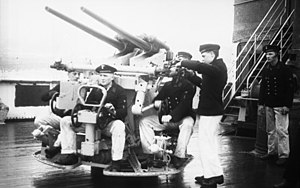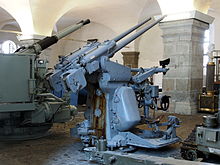3.7 cm SK C/30
| 3.7 cm SK C/30 | |
|---|---|
 3.7 cm SK C/30 on a Dopp LC/30 stabilized mount | |
| Type | Anti-aircraft cannon |
| Place of origin | Nazi Germany |
| Service history | |
| In service | 1935–45? |
| Used by | Nazi Germany Spain |
| Wars | Second World War |
| Production history | |
| Designer | Rheinmetall |
| Designed | 1930—35 |
| Manufacturer | Rheinmetall |
| Produced | 1935—1943? |
| Variants | 3.7 cm SK C/30U |
| Specifications | |
| Mass | 243 kilograms (536 lb) |
| Length | 3.074 metres (10 ft 1 in) |
| Barrel length | 2.962 metres (9 ft 9 in) L/83 |
| Shell | fixed, cased charge |
| Shell weight | 0.68 kilograms (1 lb 8 oz) |
| Caliber | 3.7 centimetres (1.5 in) |
| Action | single-shot |
| Breech | semi-automatic, vertical sliding block |
| Elevation | depends on the mount |
| Traverse | 360° |
| Rate of fire | 30 rpm (practical) |
| Muzzle velocity | 1,000 m/s (3,300 ft/s) |
| Effective firing range | 2,000 m (6,600 ft) (effective ceiling) |
| Maximum firing range | 8,500 m (9,300 yd) at 37.5° |
The 3.7 cm SK C/30[Note 1] was the German Kriegsmarine's primary 3.7 cm (1.5 in) anti-aircraft gun during the Second World War. It was superseded by the fully automatic 3.7 cm FlaK 43 late in the war.
Description
The C/30 was a single-shot, semi-automatic anti-aircraft gun that was loaded one round at a time which dropped its effective rate of fire to a mere 30 rounds per minute, far inferior to the 80-100 rounds per minute of its contemporary, the Bofors 40 mm anti-aircraft gun. The SK C/30U gun was modified for use by submarines. All mountings were suitable for use against both air and sea targets.[1]
Mountings

The Dopp LC/30 was a twin mount with each gun in a separate cradle. It had a six-man crew on the mount itself plus additional ammunition handlers. The mounting was manually traversed and elevated and was gyro-stabilized up to a limit of 19.5° degrees to counteract the roll and pitch of the ship. Most German ships, fleet torpedo boat or larger, carried at least one Dopp LC/30 mounting. The Einheitslafette C/34 (universal mounting model 34) was a single gun mounted on a pedestal with a two-man crew. Some mounts were fitted with a 8 millimetres (0.31 in) gun shield. It was used on the smaller Kriegsmarine ships like the Schnellboot. A number were used on land to supplement the anti-aircraft defenses of ports. The Ubts LC/39 submarine mount used the SK C/30U gun. It was a simple pedestal mount with a two-man crew, one of whom trained the gun with the shoulder stirrup; the other used gears to elevate the gun.[2]
| Mounting | weight | elevation |
|---|---|---|
| Dopp LC/30 | 3,670 kg (8,090 lb) | -9° to +85° |
| Ein LC/34 | 1,860–2,020 kg (4,100–4,450 lb) | -10° to +80° |
| Ubts LC/39 | 1,450 kg (3,200 lb) | -10° to +90° |
Ammunition
The SK C/30 used two types of tracer rounds. The 3.7 cm Br Sprgr Patr 40 L/4.1 Lh 37M was a high-explosive round with an incendiary filling while the 3.7 cm Sprgr Patr 40 L/4.1 Lh 37 lacked the incendiary fill, but was otherwise identical. Tracers were available in red, yellow or white and were marked on the shell by a painted band of the appropriate color. A complete round weighed 1.78 kilograms (3.9 lb).[3]
Footnotes
- Notes
- ^ SK - Schnelladekanone (quick loading cannon); C - Construktionsjahr (year of design)
- Citations
- ^ Campbell, p. 256
- ^ "German 3.7 cm/L83 (1.5") SK C/30 3.7 cm/L83 (1.5") SK C/30U". 23 March 2009. Retrieved 2009-06-11.
- ^ Hogg, p. 223
References
- Campbell, John (2002). Naval Weapons of World War Two. London: Conway Maritime Press. ISBN 0-87021-459-4.
- Gander, Terry; Chamberlain, Peter (1979). Weapons of the Third Reich: An Encyclopedic Survey of All Small Arms, Artillery and Special Weapons of the German Land Forces 1939–1945. New York: Doubleday. ISBN 0-385-15090-3.
- Hogg, Ian V. (1997). German Artillery of World War Two (2nd corrected ed.). Mechanicsville, PA: Stackpole Books. ISBN 1-85367-480-X.
